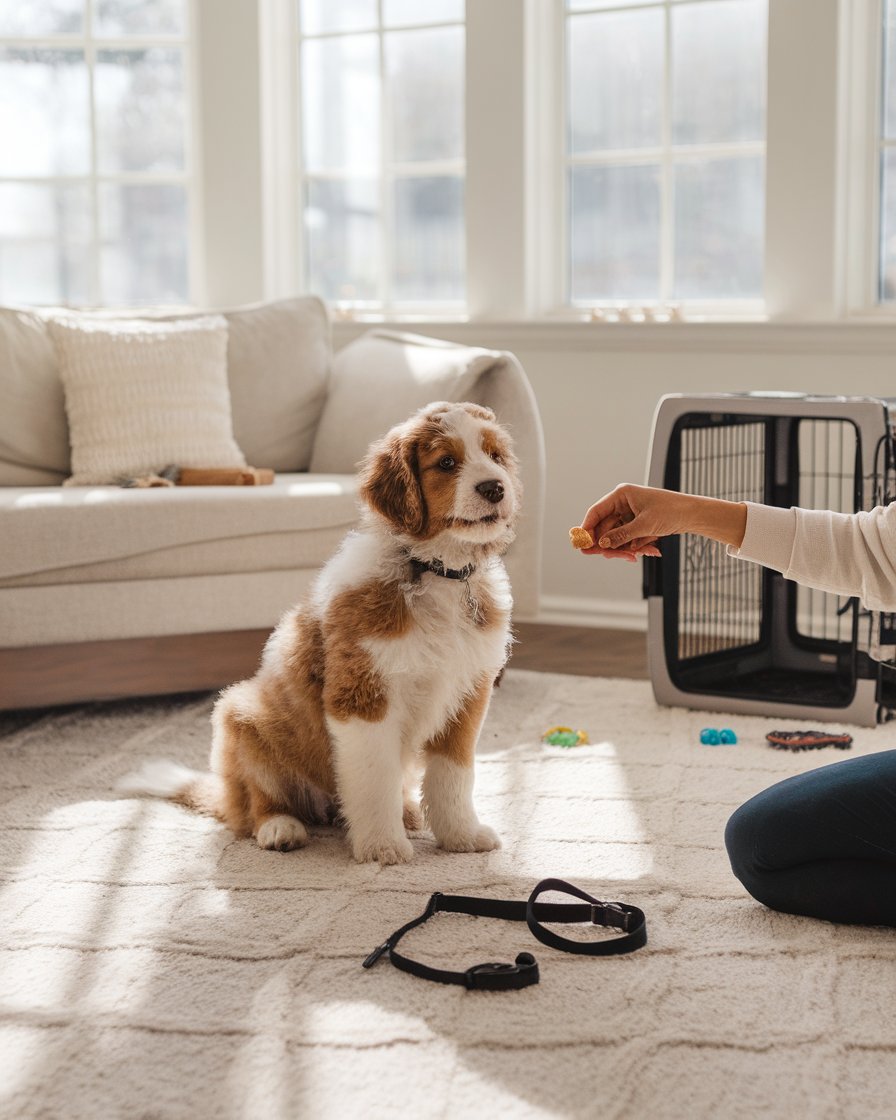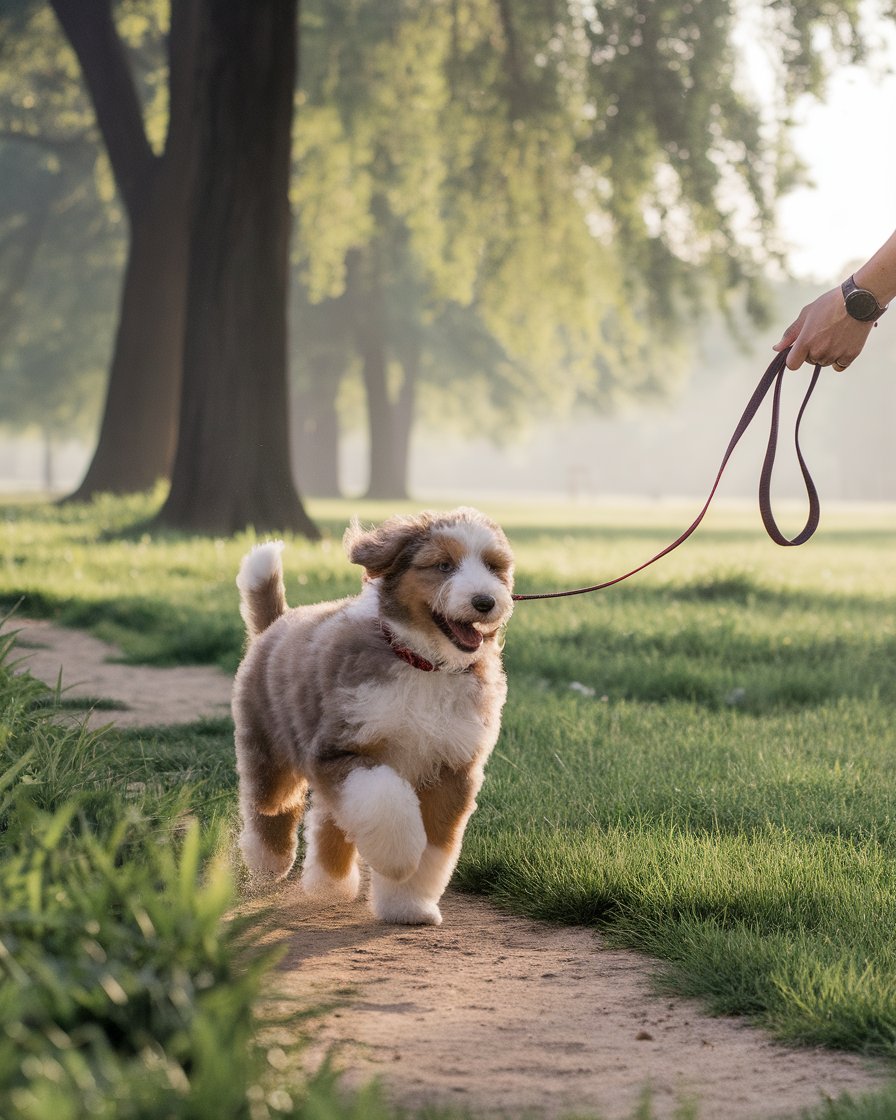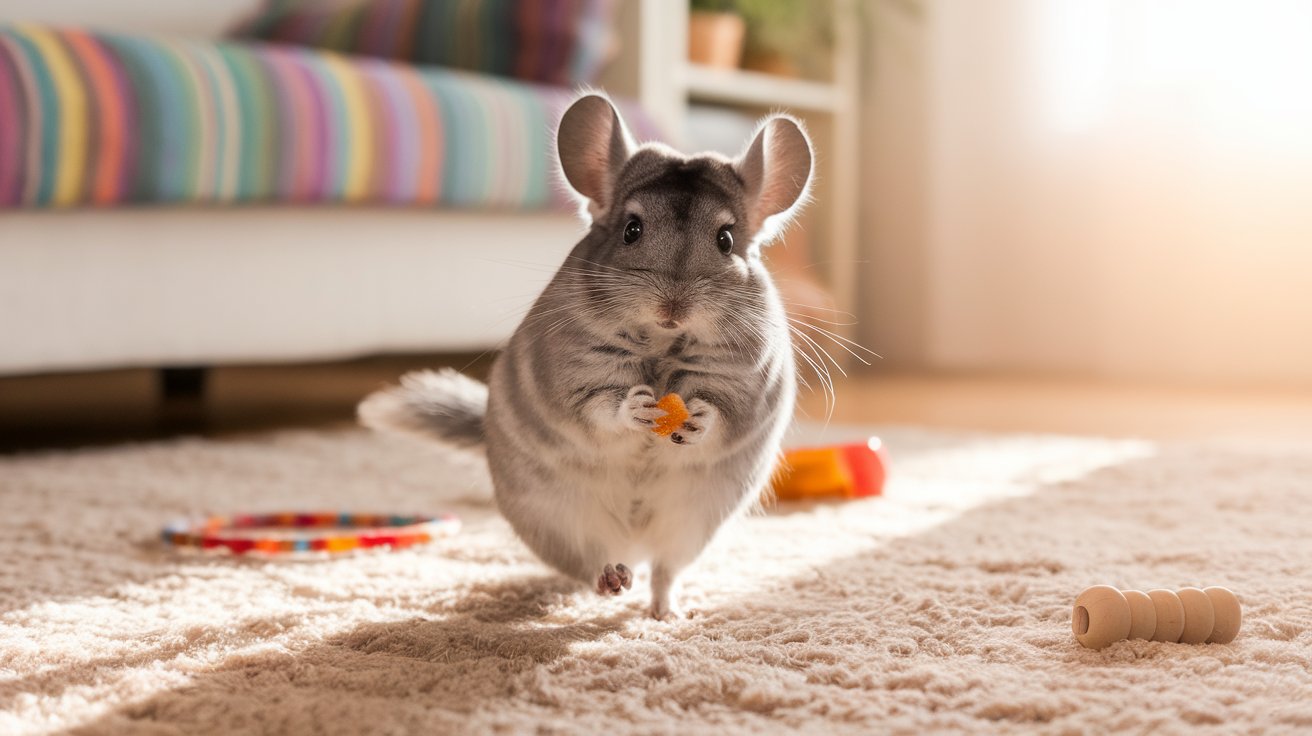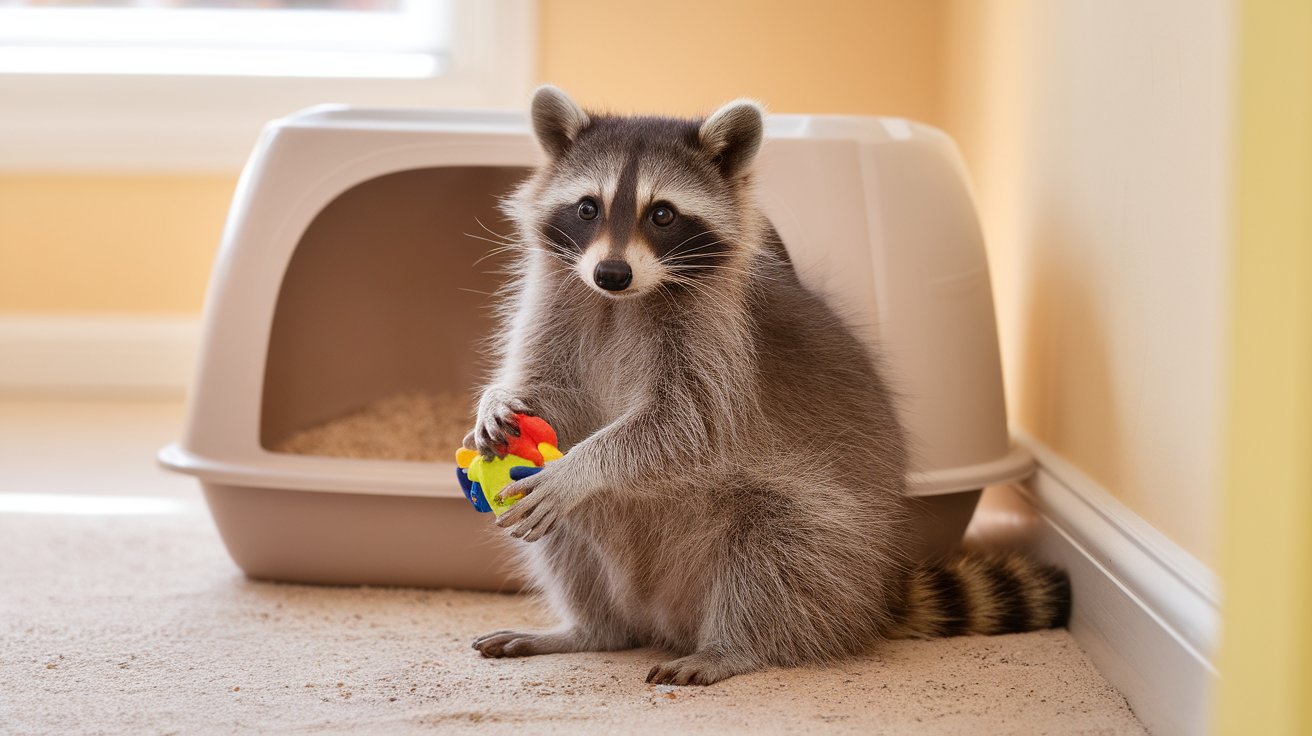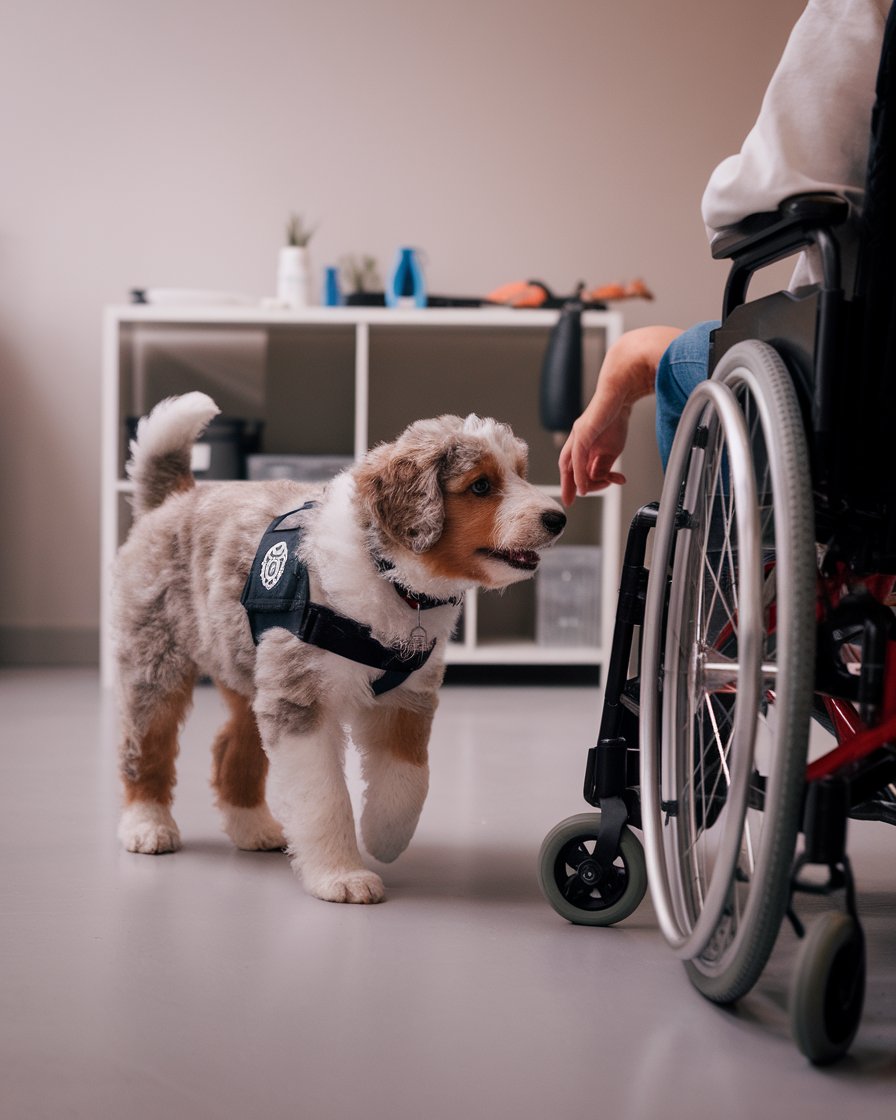Introduction
Training your Aussiedoodle puppy is one of the most important steps to ensure they grow into a well-behaved and happy doggy companion. Known for their intelligence and energy, Aussiedoodles require consistent training techniques to develop good behavior. Starting early with basic commands, such as sit and stay, will set a strong foundation. Using a collar and leash during these lessons will help control your puppy and build good habits. Additionally, teething can cause some challenges, so offering chew toys can help manage that behavior while preventing your puppy from developing undesirable habits.
When you train an Aussiedoodle puppy, it’s essential to remain patient and consistent. Each puppy’s progress may vary—what works for one may not work for another. Be mindful of behavior shaping and keep training sessions fun and engaging. Whether it’s housebreaking or teaching new tricks, using treats as positive reinforcement will motivate your puppy to repeat those good behaviors. Early socialization also plays a crucial role, ensuring your puppy adjusts well to new environments.
Key Takeaways
- Early training for your Aussiedoodle puppy is essential to establish good behavior and prevent issues like barking or chewing.
- Teaching basic commands such as sit, stay, and come creates a foundation for safety and clear communication with your puppy.
- House training and crate training help your puppy adjust to home life and manage separation anxiety effectively.
- Short, fun training sessions keep your Aussiedoodle engaged while reinforcing desired behaviors through positive reinforcement.
- Advanced tricks like roll over and play dead challenge your Aussiedoodle’s intelligence and strengthen the bond between dog and owner.
- With the right socialization and training, Aussiedoodles can be trained for special roles, including therapy or service dogs.
Training Your Aussiedoodle Puppy
Training your Aussiedoodle puppy is essential for raising a well-behaved and happy companion. This breed, a mix of Australian Shepherd and Poodle, is known for its intelligence and energy, making training both enjoyable and necessary. Early training helps teach your puppy basic commands, housebreaking, and good manners, which are critical during puppyhood. It’s also important to engage your Aussiedoodle in regular mental stimulation to prevent undesirable behaviors like excessive barking or chewing. Establishing a training routine from the first few months will help reinforce good behavior and discourage bad habits, ensuring your new puppy grows into a well-adjusted adult dog.
How To Train Your Aussiedoodle Puppy into an Awesomedoodle
-
Start Early with Basic Commands
It’s essential to begin training your Aussiedoodle puppy as soon as possible. Early training establishes the foundation for good behavior and obedience. Commands like sit, stay, and come are crucial for maintaining safety and communication with your pup. Starting early also helps prevent the development of undesirable behaviors like excessive barking or jumping. -
Use Positive Reinforcement
Positive reinforcement is the key to successful training. Use treats, praise, and toys to reward good behavior, which encourages your puppy to repeat those actions. Avoid harsh corrections or scolding, as Aussiedoodles respond much better to rewards. This approach also strengthens the bond between you and your puppy, making training more enjoyable. -
Socialize Your Puppy from the Beginning
Socialization is an important part of raising a well-adjusted Aussiedoodle. Introduce your puppy to various environments, people, and other dogs from an early age. This exposure helps reduce fear and anxiety while teaching them how to interact properly with others. Early socialization can prevent issues like barking at people or being fearful of new experiences. -
Keep Training Sessions Short and Engaging
Aussiedoodles are intelligent and energetic, but they can lose focus quickly if training sessions are too long. Keep each session short, around 10-15 minutes, to maintain their attention. Incorporate playtime and activities to keep the training fun and engaging. Short sessions also help your puppy retain information better without becoming overwhelmed. -
Housebreaking and Crate Training
Consistency is critical when housebreaking and crate training your Aussiedoodle. Establish a regular potty schedule and use the crate as a safe space for your puppy. Crate training helps with housebreaking and provides your puppy with a place to relax and feel secure. Remember to use positive reinforcement when your puppy successfully follows the routine. -
Introduce Advanced Tricks and Mental Stimulation
Once your puppy has mastered the basics, challenge them with advanced tricks like rolling over or fetching specific items. Aussiedoodles thrive on mental stimulation, and these challenges will keep them engaged and happy. Regularly introducing new tricks helps prevent boredom, which can lead to undesirable behaviors like chewing or digging.
The Importance of Training Your Puppy
The importance of training your puppy cannot be overstated, especially with an energetic and smart breed like the Aussiedoodle. Training your new doodle from the start lays the groundwork for good behavior. It helps prevent separation anxiety, excessive barking, and undesirable behaviors like chewing on furniture. Proper obedience training fosters a strong bond between you and your new family member, making sure that your puppy learns to respond to commands and feels secure in their environment. Additionally, it’s important to use positive reinforcement like treats to encourage your puppy during these critical first few months.
Setting Training Goals for Your Aussiedoodle
Setting clear training goals is crucial when bringing home a new doodle puppy. Begin by focusing on basic commands such as sit, stay, and leash walking. These foundational skills are essential for shaping the behavior of your Aussiedoodle and making sure they become well-mannered adult dogs. Keep your training sessions short and consistent to ensure your puppy stays engaged and doesn’t get overwhelmed. As your training efforts progress, introduce crate training and housebreaking techniques to help your puppy adjust to their new home and routine. These steps will set the stage for a lifetime of good manners and proper behavior.
Basic Training Lessons for Your New Aussiedoodle Puppy
Basic training for your new Aussiedoodle puppy is essential to help them adjust to their new environment and learn proper behavior. Aussiedoodles are an intelligent breed, and starting early with training can make a big difference. The goal is to establish good habits during puppyhood while also preventing common issues like excessive barking or chewing. By implementing a consistent routine, using positive reinforcement, and giving your puppy plenty of praise, you’ll be on your way to raising a well-mannered companion. Basic commands and house training are the foundation of good behavior, helping your puppy grow into a well-adjusted dog.
Case Study: Early Training Success with Aussiedoodle Puppies
A dog training facility in Oregon recently worked with a group of Aussiedoodle puppies to see how early training could impact their behavior. They started training 15 Aussiedoodle puppies at just eight weeks old, using positive reinforcement like treats, praise, and short, fun sessions. The key was keeping each session only about 10-15 minutes long to hold the puppies’ attention and energy.
The focus was on teaching basic commands like sit, stay, and come, while also working on housebreaking and crate training. They made the crates cozy with blankets and toys, turning them into a safe space for the puppies. After three months, all 15 puppies showed big improvements in behavior, like less barking and adapting to new environments faster. This case proves how important it is to start early, using consistency and positive training methods to raise a well-behaved Aussiedoodle.
Teaching Commands Like Sit, Stay, and Come
Teaching basic commands such as sit, stay, and come is a fundamental part of Aussiedoodle training. These commands not only ensure safety but also help establish clear communication between you and your puppy. Start training your new doodle puppy by using short, frequent sessions to keep them engaged. Always use positive reinforcement like treats and praise to encourage them when they perform the command correctly. These basic skills are vital for shaping desired behaviors and preventing issues like jumping on people or running off when off-leash. Consistency in both verbal cues and timing will lead to better results and a well-behaved Aussiedoodle.
House Training and Crate Training for Aussiedoodles
House training and crate training go hand in hand when teaching your Aussiedoodle puppy how to behave at home. Begin crate training by introducing the crate as a comfortable and safe space. Make it inviting with chew toys and blankets, encouraging your puppy to associate the crate with positive experiences. Housebreaking your Aussiedoodle requires patience and consistency, using a regular schedule for potty training. Positive reinforcement is key to helping your puppy understand where and when to go. Proper crate training not only makes house training easier but also helps manage separation anxiety, giving your puppy a sense of security in their own space.
Learning More AwesomeDoodle Tricks
Teaching your Aussiedoodle puppy fun and engaging tricks is a great way to keep them mentally stimulated while strengthening your bond. Aussiedoodles, known for their intelligence and energy, thrive when they are challenged with new tasks. Once your dog has mastered the basics like sit and stay, you can start introducing more advanced commands. Training should be a fun experience for both the owner and the dog, as it encourages continued learning and good behavior. By using positive reinforcement and keeping sessions upbeat, your puppy will not only learn quicker but also enjoy the process of discovering new skills.
Engaging in Short and Fun Training Sessions
To maintain your Aussiedoodle’s attention, it’s important to keep training sessions short and playful. Long sessions can tire your dog and reduce their enthusiasm for learning. Aim for about 10-15 minutes of training per session, incorporating breaks to let your dog play and release energy. Use a combination of treats, praise, and playtime to keep your puppy excited about learning. This approach encourages your Aussiedoodle to look forward to training, reinforcing positive behaviors. Training methods that emphasize fun also ensure that your dog stays mentally stimulated, preventing boredom, which can lead to undesirable behaviors like barking or chewing.
Teaching Advanced Tricks Like Roll Over and Play Dead
Once your Aussiedoodle has mastered basic commands, you can start teaching more advanced tricks like roll over and play dead. These tricks require patience, but they are excellent for challenging your dog’s intelligence. Start by breaking down each trick into small steps, using clear verbal commands and a marker, such as a clicker, to signal when your dog performs the right action. Reward your dog with treats and praise to reinforce the desired behavior. Training your pup advanced tricks not only helps with obedience but also strengthens the bond between you and your dog, making training a fun and rewarding experience for both.
“Training is not about being harsh, it’s about showing the way forward, creating a bond of trust and understanding.” – Cesar Millan
Training Your Aussiedoodle for Special Roles
Aussiedoodles are not only great companions, but they also have the potential to take on special roles like therapy and service dogs. Their intelligence and friendly nature make them well-suited for tasks that require emotional support or physical assistance. Training your Aussiedoodle for these roles takes patience and consistency but can lead to a rewarding partnership. Starting early with obedience training and gradually working towards more specific tasks is key. Whether you’re aiming to train your puppy as a therapy dog or a service dog, the process will help shape a well-behaved, confident, and helpful companion.
Training Your Puppy to Be a Therapy Dog
Training an Aussiedoodle to be a therapy dog requires careful attention to their temperament and socialization. Therapy dogs need to be comfortable around people and enjoy offering emotional support. Start by socializing your puppy early, introducing them to different environments and people, which helps them adapt to varied social situations. Use positive reinforcement to encourage calm, friendly behavior, and ensure the puppy remains confident in new settings. Training methods for therapy dogs often involve teaching them how to stay calm, respond to cues, and provide comfort to those in need. With consistent training, your Aussiedoodle can excel in this supportive role.
Teaching Your Aussiedoodle to Assist as a Service Dog
For an Aussiedoodle to become a service dog, training focuses on teaching them specific tasks that help their owner. Start with basic commands and gradually introduce task-specific training, such as retrieving objects, providing mobility support, or even alerting to medical conditions. Consistency is key, and each training session should build on previous efforts. Patience and repetition are essential as you work with your puppy to shape these advanced behaviors. Proper socialization is also important to ensure your Aussiedoodle can remain focused and effective in a variety of environments. A well-trained service dog can greatly enhance their owner’s quality of life.
Conclusion
Training your Aussiedoodle puppy is a journey that requires patience, consistency, and proper guidance. By starting early with basic commands and utilizing tools like a collar and leash, you set the foundation for raising a well-behaved Aussiedoodle. It’s important to use positive reinforcement rather than scold, as this encourages your puppy to repeat good behaviors and prevents undesirable ones such as barking or chewing on furniture.
As your puppy starts to learn, ensure that you provide them with a comfortable environment, including the right crate for housebreaking and safe spaces. Training tips from professional dog trainers can also offer valuable insights into handling this critical time in your puppy’s life. Whether it’s advanced obedience or managing behaviors like mouthing, with the right techniques and care, your Aussiedoodle will grow into a well-mannered companion.


